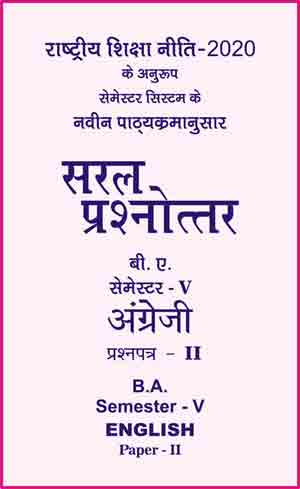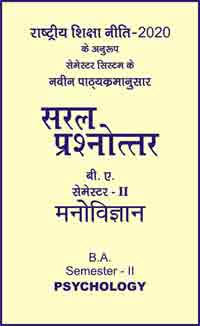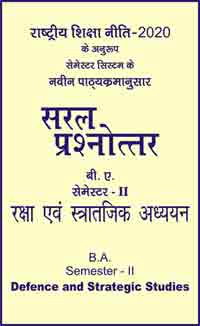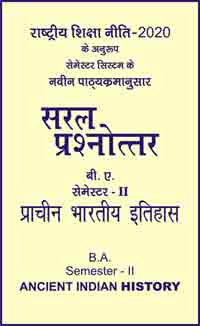|
बी ए - एम ए >> बीए सेमेस्टर-5 पेपर-2 अंग्रेजी बीए सेमेस्टर-5 पेपर-2 अंग्रेजीसरल प्रश्नोत्तर समूह
|
5 पाठक हैं |
|||||||
बीए सेमेस्टर-5 पेपर-2 अंग्रेजी - सरल प्रश्नोत्तर
Question- Discuss plot of the novel The White Tiger.
Or
What is the plot in the White Tiger? Discuss?
Answer-
The White Tiger, Aravind Adiga's introduction novel that won the 2008 Man Booker Prize as well as received a great deal of critical commendation. This novel is an innovative and persuasive story about modern India. The book interesting from the perspective that how Adiga intertwines such a broad gamut of aspects of life in India-from local democracy to caste to religion to family duty to the rising technology centers and culture of entrepreneurism.
The novel contains massive amount, without being an extensive epic or losing its firm focus. The White Tiger is a moving story and an eyeopening picture of Indian societyus brown and yellow men at the top of the pyramid, and we'll rule the world." He's talking about the phenomenon at the heart of this dazzling narrative: the emergence of that muchheralded muchheralded economic powerhouse, the "new India"..
You have, no doubt, read about it. In fact, you may have done so courtesy of Aravind Adiga, who is Time magazine's Asia correspondent. But with The White Tiger, Adiga sets out to show us a part of this emerging country that we hear about infrequently: its underbelly. We see through the eyes of Balram, who was born into the "darkness" of rural India, but entered the light that is Delhi via a job as driver to Mr Ashok, the son of a rich landlord. Now, though, Balram has escaped servitude and is himself a rich businessman. What's more, his unlikely journey involved a murder. The result is an Indian novel that explodes the clichés ornamental prose, the scent of saffron associated with that phrase. Welcome, instead, to an India where Microsoft callcentre workers tread the same pavement as beggars who burn street rubbish for warmth.
Adiga's whimsical conceit is to give us Balram's story via seven letters to the Chinese prime minister, who, Balram has decided, must be told the truth about India before a forthcoming state visit. So Balram begins: he tells of Delhi's servants, who live in rotting basements below the glass apartment blocks that are home to their employers. He tells of how Ashok's family bribe government ministers, and how national elections are rigged. Ashok, trendy and liberal, is forever expressing guilt over Balram's treatment, but his fine words never come to anything.
It's a thrilling ride through a rising global power; a place where, we learn, the brutality of the modern city is compounded by that of ageold tradition. "In the old days there were one thousand castes and destinies in India," says Balram. "These days there are two castes: Men with Big Bellies, and Men with Small Bellies." Soon enough, of course, Balram must tell us just how, exactly, he grew a Big Belly himself. Tired of a life of servitude, he takes the violent action that secures his place among Delhi's rich. Adiga's plot is somewhat predictable the murder that is committed is the one that readers will expect throughout but The White Tiger suffers little for this fault. Caught up in Balram's world and his wonderful turn of phrase the pages turn themselves. Brimming with idiosyncrasy, sarcastic, cunning, and often hilarious, Balram is reminiscent of the endless talkers that populate the novels of the great Czech novelist Bohumil Hrabal. Inventing such a character is no small feat for a firsttime novelist...
Archdefenders of India's claim to be truly democratic, evenhandedly prosperous and corruptionfree (and these must be few outside of the Indian cabinet) might balk at The White Tiger. Everyone else, surely, will be seduced by it.
The White Tiger
The White Tiger takes place in modern day India. The novel's protagonist, Balram Halwai is born in Laxmangarh, Bihar, a rural village in "the Darkness". Balram narrates the novel as a letter, which he wrote in seven. consecutive nights and addressed to the Chinese Premier, Wen Jiabao. In his letter, Balram explains how he, the son of rickshaw puller, escaped a life of servitude to become a successful businessman, describing himself as a successful entrepreneur. Balram begins the novel by describing his life in Laxmangarh. There he lived with his grandmother, parents and brother and extended family. He is a smart child; however, he is forced to quit school in order to help pay for his cousin sister's dowry. He begins to work in a teashop with his brother in Dhanbad. While working in the teashop he begins to learn about India's government and economy from the customers' conversations. Balram describes himself as a bad servant and decides that he wants to become a driver.
Balram learns how to drive and gets a job driving Ashok, the son of the Stork, the local landlord. During a trip back to his village Balram disrespects his grandmother and tells the reader and the Chinese Premier that in the next eight months he intends to kill his boss. Balram moves to New Delhi with Ashok and his wife Ms Pinky Madam. Throughout their time in New Delhi, Balram is exposed to the extensive corruption of India's society, including the government. In New Delhi the separation between poor and wealthy becomes even more evident by the juxtaposition of the wealthy with poor city dwellers.
One night Pinky decides to drive the car by herself and hits something." She is worried that it was a child and the family eventually decides to frame Balram for the hit and run. The police, however, corrupt and lazy, tell them that no one reported a child missing so that luckily no further inquiry is done. Ashok becomes increasingly involved with the corrupt government itself. Balram then decides that the only way that he will be able to escape India's "Rooster Coop" will be by killing and robbing Ashok. One raining day he murders Ashok by bludgeoning him with a broken liquor bottle. He then manages to flee to Bangalore with his young nephew. There he bribes the police in order to help start his own driving service. When one of his drivers kills a bike messenger Balram pays off the family and police. Balram explains that his family was almost certainly killed by the Stork as retribution for Ashok's murder. At the end of the novel Balram rationalizes his actions by saying that his freedom is worth the lives of Ashok and his family and the monetary success of his new taxi company.
|
|||||
- Question- Discuss in detail the development of English novel from the eighteenth century to the Modern Age.
- Question- What do you understand by Novel? What are the elements which are to considered in plot construction.
- Question- Write a note on characterization of a novel. How much is it important for development of a novel?
- Question- Write a short note on narrative technique of a novel.
- Question- Write a note on the elements of a short story.
- Question- Write a note on Fielding's plot construction.
- Question- Write a note on Fielding's characterisation.
- Question- Define plot. What are the qualities of an ideal plot ?
- Question- Write a short note on the plot construction of a novel.
- Question- What is the difference between Flat Character and Round Character?
- Question- Write a short note on the characterization of a novel.
- Question- Write a short note on narrative technique of a novel.
- Question- What is a short story? What is the difference between a short story and a novel?
- Question- What is a picaresque novel? Who are the main exponents of the picaresque novel?
- Question- What is a historical novel? What is the difference between history and a historical novel? Name a few historical novelists and their creation.
- Question- What do you know about the Gothic novel?
- Question- Write a note on Epistolary novel.
- Question- Write a note on the Regional novel.
- Question- Point out the chief characteristics of the Picaresque novel.
- Question- Point out the chief characteristics of the historical novel.
- Question- Write an essay on Sir Walter Scott's contribution to historical novel.
- Question- Point out the chief characteristics of Gothic novel.
- Question- Point out the chief characteristics of the Regional novel.
- Question- What is a regional novel? Name a few novelists of this genre and their novels.
- Question- What is a Picaresque novel?
- Question- What do you know about Historical novel?
- Question- What do you know about Gothic novel?
- Question- Examine the merits of Sir Walter Scott as a Historical novelist.
- Question- What do you mean by domestic novel?
- Question- What do you mean by the Stream of consciousness? Who. coined the term?
- Question- What is a Epistolary novel?
- Question- What do you know about the Regional novel?
- Question- Trends in 20th and 21st Century Fiction Discuss as a sub-genre of crime fiction and mystery.
- Question- Define utopian fiction. Discuss its history and origin.
- Question- What is campus novel? Explain its history and development.
- Question- Write a note on Detective novel.
- Question- Write a note on Science fictions.
- Question- Write a note on Meta fiction.
- Question- Define mythology. Explain the rise of mythological fiction in India.
- Question- What is space fiction? Discuss its characteristics and example.
- Question- Define chick lit. Discuss its characteristics and example.
- Question- Define junk fiction. Explain its characteristics and types of junk fiction.
- Question- Write a short note on detective novel.
- Question- Write short note on Science fiction.
- Question- What is Meta fiction?
- Question- What is Science Fiction?
- Question- What is utopian fiction?
- Question- Why are campus novels important? What kind of characters are in campus novels?
- Question- What is dystopian fiction?
- Question- Discuss feminism in mythological fiction.
- Question- Why are campus novels important? What kind of characters are in campus novels?
- Question- What is chic lit fiction?
- Question- Write a note on the life and works of Charles Dickens.
- Question- Write a note on Charles Dickens as a novelist.
- Question- Write a note on the development of English novel up to Dickens.
- Question- Write a note on Dicken's social criticism. What was Dickens' attitude toward various social evils of the day?
- Question- Describe Dickens as a representative of his age.
- Question- Write a note on Dickens as a social reformer.
- Question- Write a note on the social background of Dickens.
- Question- Write a note on Dickens's contribution to English novel.
- Question- Discuss symbolism as a structural elements in A Tale of two cities.
- Question- Discuss Dickens's art of characterization in the novel "A Tale of Two Cities".
- Question- What is meant by criticism of life? What is the 'vision of life"? Point out the criticism and vision of life in A Tale of Two Cities.
- Question- Write a note on the blend of realism and idealism in the novels of Dickens.
- Question- "Dickens' characters are both types and individuals.” Discuss.
- Question- Write a note on Dickens as a satirist.
- Question- What is the significance of the name "Jacques" in A Tale of Two Cities?
- Question- In Book 2, Chapter 21 of A Tale of Two Cities, what is happening in France that upsets Mr. Jarvis Lorry?
- Question- Write the life of Thomas Hardy and about his career.
- Question- What are the three phases of Hardy's writing? What were the issues he dealt with in those three phases?
- Question- Write short notes on the major characters of the novel, and show how Hardy develops these characters in the course of the novel.
- Question- Who is the heroine of 'Far From the Madding Crowd"? How doy o you justify her position as the heroine?
- Question- Explain the tragic vision of Hardy in Far From the Mad ding Crowd.
- Question- Why does Bathsheba reject Gabriel's proposal at the start of the novel?
- Question- How is sexual desire portrayed in the novel?
- Question- How was Oak's life saved by Bathsheba?
- Question- How was Oak completely ruined?
- Question- Describe the feast after sheep-shearing.
- Question- How are Oak and Bathsheba ultimately a happy couple?
- Question- Discuss Jane Austen as a realist.
- Question- Point out Jane Austen's contribution to the English novel.
- Question- Write a note on characterisation of Jane Austen with special reference to 'Pride and Prejudice'.
- Question- Is there artistic detachment in Jane Austen ? Write a brief note in support to your view with illustrations.
- Question- Sketch the character of Fitzwilliam Darcy.
- Question- Sketch the character of George Wickham.
- Question- Do you agree with the view that the novel 'Pride and Prejudice' revolves around two themes of 'Pride and Prejudice'? Give reasons for your answer?
- Question- Write an essay on the sequence of events in 'Pride and Prejudice'?
- Question- Write a note on Life Sketch of George Eliot Life Sketch of George Eliot
- Question- Discuss the humour elements in George Eliot's The Mill on the Floss.
- Question- Critically examine the artistic and the philosophic dimensions of the ending of The Mill on the Floss in the light of the view of the individual and society presented in the novel.
- Question- Compare and contrast Maggie's love for Philip, Stephen, and Tom.
- Question- Describe the thematic import of Maggie's decision to relinquish Stephen.
- Question- Compare and contrast Tom and Maggie. How much are their respective successes and failures a function of gender and how much a function of their distinct characteristics?
- Question- Compare and contrast Tom and Mr. Tulliver. Why does Tom succeed where Mr. Tulliver failed?
- Question- Write a note on life kketch of Toni Morrison.
- Question- Discuss the narrative strategies used by the writer in The Bluest Eye.
- Question- Discuss the narrative structure of the novel. Why might Morrison have chosen to present the events in a non- chronological way?
- Question- What does the title of The Bluest Eye mean?
- Question- How are Pecola Breedlove and Maureen Peal foils to one another?
- Question- The Bluest Eye uses multiple narrators, including Claudia as a child, Claudia as an adult, and an omniscient narrator. Which narrative point of view doyou think is most central to the novel and why?
- Question- Who do you think is the most sympathetic character in the novel and why?
- Question- The Bluest Eye is a novel about racism, and yet there are relatively few instances of the direct oppression of black people by white people in the book. Explain how racism functions in the story.
- Question- Write a note on Life Sketch of The Harper Lee.
- Question- Analyze the childhood world of Jem, Scout, and Dill and their relationship with Boo Radley in Part One.
- Question- What is Atticus's relationship to the rest of Maycomb? What is his role in the community?
- Question- Discuss the role of family in To Kill a Mockingbird, paying close attention to Aunt Alexandra.
- Question- Discuss the author's descriptions of Maycomb. What is the town's role in the novel? Analyze the author's treatment of Boo Radley. What is his role in the novel?
- Question- Discuss Atticus's parenting style. What is his relationship to his children like? How does he seek to instill conscience in them?
- Question- Identify Atticus Finch, Jean Louise (Scout) Finch, Jem Finch, Maycomb, Calpurnia, Charles Baker (Dill) Harris, The Radley Place, Stephanie Crawford, Arthur (Boo) Radley, Miss Caroline Fisher, Walter Cunningham, and Burris Ewell.
- Question- Why did Mr. Cunningham's mob leave?
- Question- In Chapter 2 of To Kill a Mockingbird what does Miss Caroline, Scout's first-grade teacher, represent?
- Question- In Chapter 6 of To Kill a Mockingbird why is Jem is determined to retrieve his pants from the fence despite the danger of meeting up with Nathan Radley?
- Question- What is the significance of the title To Kill a Mockingbird according to Atticus's reasoning in Chapter 10?
- Question - Comment upon the role of the lions in The Old Man And The Sea.
- Question- Comment upon the symbolic role played by Di Maggio in the novel "The Old Man And The Sea'...
- Question- Comment upon the arm-wrestling episode in the novel 'The Old Man and The Sea'.
- Question- Comment upon the marlin separating episode in the novel "The Old Man and The Sea".
- Question- Write a note on the major themes of the novel The Old Man and The Sea'.
- Question- Write a brief note on The Old Man And The Sea' as a tragedy.
- Question- Which claims your attention more in The Old Man And The Sea' its narrative or allegory?
- Question- The hero of the novel "The Old Man And The Sea' is really a Christfigure. Comment.
- Question- Write a brief note on Hemingway hero or the autobiographical hero.
- Question- In the fight of the old man against the giant fish what we see is a "battle of attrition". Comment.
- Question- Write a note on Life Sketh of John Ernst Steinbeck.
- Question- Analyze Tom Joad's growth throughout the novel. Despite the fact that Tom is not a young boy, does the novel have the characteristics of a bildungsroman, or coming-of-age story?
- Question- Discuss the development of Tom Joad as a character. How does he grow throughout the book? What effects do Jim Casy's imprisonment and death have on his development?
- Question-What themes related to family are in The Grapes of Wrath?
- Question- How does the erosion described in Chapter 1 of The Grapes of Wrath relate to the Bank monster described in Chapter 5?
- Question- How do the roles of Ma and Pa differ in the Joad family in The Grapes of Wrath?
- Question- In The Grapes of Wrath how is the Gila monster described in Chapter 13 comparable the Bank monster?
- Question- What biblical allusions does John Steinbeck include in The Grapes of Wrath and how does he use them?
- Question- How do the roles of Ma Joad and Pa Joad within the family change in The Grapes of Wrath?
- Question- In The Grapes of Wrath, why does the Joad family deteriorate after the Joads leave Oklahoma?
- Question- Write a note on Life Sketch of Aravind Adiga
- Question- Discuss plot of the novel The White Tiger.
- Question- Explain literary analysis of The White Tiger by Aravind Adiga.
- Question- Critical analysis of the novel The White Tiger written by Aravind Adiga.
- Question- What is Balram's attitude toward religion? How does this develop throughout the novel?
- Question- How does this portrayal of India differ from more typical literary depictions of India?
- Question- Why does Balram choose to address his narrative to the Premier of China? How would the story have been different without this framing device?
- Question- Discuss Balram's many names throughout the novel, and how each one represents an aspect of him.
- Question- What does Balram's experience in Bangalore reveal about the Indian economy in an increasingly globalized world?
- Question- Attempt critical analysis of the novel 'Dalits, Dynasty and She' by Sanjay Chitranshi.
- Question- Explain the plot of the novel 'Dalits, Dynasty and She 'written by Sanjay Chitranshi.
- Question- Discuss the Novel 'Dalits, Dynasty and She' by Sanjay Chitranshi.
- Question- Who was Shanti Devi?
- Question- Write a' character sketch of Ram Chandra.
- Question- Write a note on Life Sketch of Sudha Murty.
- Question- What are the major themes of the novel "Dollar Bahu"?
- Question- Discuss how the notion of self sacrifice is exclusively attributed to a particular gender in Indian society. How they thrive through the difficult situation in life when they are implanted to a new atmosphere.
- Question- Write a note on the title "Dollar Bahu?".
- Question- Write a note on the end of the novel "Dollar Bahu".
- Question- Discuss the central theme of Dollar Bahu.














